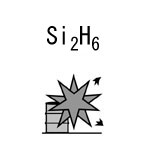| Case Name |
Fire of special material gas come into contact with air in exhaust piping at a semiconductor factory |
| Pictograph |

|
| Date |
September 17, 1995 |
| Place |
Tateyama, Chiba, Japan |
| Location |
Semiconductor parts factory |
| Overview |
At a semiconductor factory, the manufacturing plant restarted after a power failure. The exhaust pipe for disilane was damaged by momentary combustion. In down-stream in the piping, an unusual temperature rise was found during repair work, and nitrogen was introduced for substitution. The blind plate was loosened for an inspection inside. Then, air entered, and residual material in the piping reacted, flames blew off, and four workers were injured. The flammable disilane was not completely replaced by nitrogen at dead-end piping. Equipment and the work method were unsuitable for handling disilane. |
| Incident |
A fire occurred at a semiconductor factory. A silicon chip manufacturing unit restarted after returning from a power failure caused by a typhoon. The exhaust piping for disilane was damaged during restart. An unusual temperature rise was found at down-stream piping during repairing the breakage. After nitrogen substitution, a blind plate was loosened for a check. Then, flames blew off and four persons were injured. |
| Processing |
Consumption and usage |
| Substance |
Disilane, Fig2 |
| Monosilane, Fig3 |
| Hydrogen, Fig4 |
| Type of Accident |
Fire |
| Sequence |
08:31 on September 17th, 1995. The manufacturing unit stopped completely due to a power failure of about 10 seconds due to the approach of a typhoon.
14:00. A check and confirmation were carried out and the unit restarted in order. Exhaust flexible piping for disilane was damaged during restart.
Repairs of the breakage and replacement of a vacuum pump started.
An unusual temperature rise was found at a downstream part of the piping during repair. Nitrogen was substituted through the nearest nozzle.
16:40. There was no flexible piping for replacing. A blind plate was loosened before replacement to check the piping. Ignition occurred and flames blew off. Four workers got burnt in their faces.
16:41. Emergency rescue of a fire brigade was called for.
16:55. The injured were carried to a hospital. |
| Cause |
The cause of the piping rupture in the disilane exhaust system was as follows. Air entered the piping during a long power failure. Remaining disilane in the pipe burned with the air at the discharge side of the pump.
The cause of the flames blowing off, which resulted in burns, was as follows.
As substitution from disilane to nitrogen was imperfect in the dead-end piping, gas remained in the piping. It reacted with the air that flowed from the flange on being loosened. |
| Response |
There was no fire although the remaining disilane ignited. The injured were treated immediately. |
| Countermeasures |
Ensure an emergency electric power source at the time of a power failure.
Contamination prevention of air at the time of repair and a check.
Improvement of the work procedure at the time of abnormalities and repair.
Removing no-flow parts, such as dead-end piping.
Using monosilane instead of disilane. |
| Knowledge Comment |
As special material gas has toxicity and spontaneous ignition properties, it needs a detailed plan and sufficient caution in handling it. An error in dealing with an abnormality during a power failure and the abnormality itself should be corrected. However, whether this can be foreseen or cannot will depend on the recognition that air or/and water can cause ignition and an explosion.
As time for diffusion is required, gas substitution in dead-end piping cannot be hurried. |
| Background |
Equipment and the working method were unsuitable for disilane, which ignites automatically in contact with air. Regarding the facilities, when a power failure occurs, installations that prevent air from contaminating are required. Sufficient time was required for gas substitution in dead-end piping. |
| Incidental Discussion |
There are many accidents with dead-end piping. This was one of them. |
| Reason for Adding to DB |
Example of explosion of hazardous special material gas used in the semiconductor industry |
| Scenario |
| Primary Scenario
|
Poor Value Perception, Poor Safety Awareness, Inadequate Risk Recognition, Ignorance, Insufficient Knowledge, Insufficient Experience, Planning and Design, Poor Planning, Poor Purge Planning, Usage, Maintenance/Repair, Preoaration Work, Regular Movement, Careless Movement, Insufficient Recognition, Bad Event, Chemical Phenomenon, Burning, Bodily Harm, Injury, 4 person injured, Loss to Organization, Economic Loss, Manetary Damage 10 million yen
|
|
| Sources |
Introduction of information, The High Pressure Gas Safety Inst. of Japan Kyushu branch. Kyushu district high-pressure gas disaster prevention council proceeding, No.103, p.16 (1997).
Outline of significant accidents in 1995. Safety yearbook, p.236.
The Res. Inst. of Industrial Safety material. (closed).
|
| Number of Injuries |
4 |
| Multimedia Files |
Fig2.Chemical formula
|
|
Fig3.Chemical formula
|
|
Fig4.Chemical formula
|
| Field |
Chemicals and Plants
|
| Author |
ITAGAKI, Haruhiko (Japan National Institute of Occupational Safety and Health)
TAMURA, Masamitsu (Center for Risk Management and Safety Sciences, Yokohama National University)
|
|